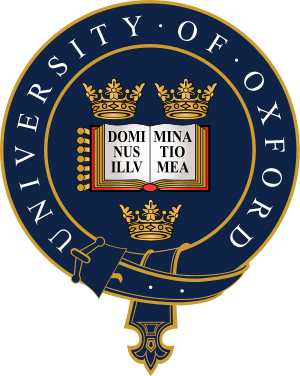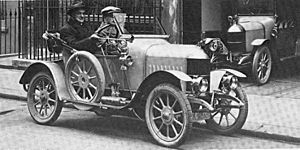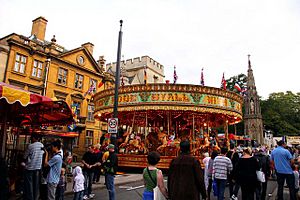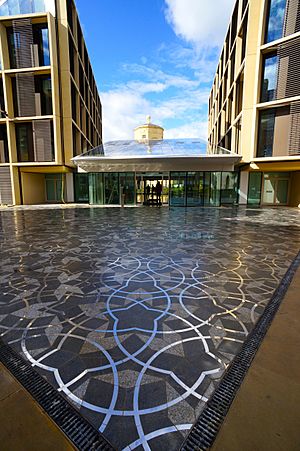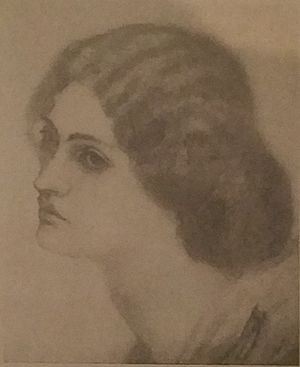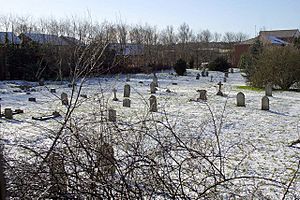Timeline of Oxford facts for kids
Welcome to the exciting history of Oxford, a famous city in England! Oxford is known for its incredible university, which has been a center of learning for hundreds of years. This timeline will take you on a journey through the past, showing you how Oxford grew from ancient times into the vibrant city it is today, filled with amazing colleges and important discoveries.
Contents
- Ancient Times: Before the 12th Century
- The 12th Century: A Time of Growth
- The 13th Century: Colleges Begin to Form
- The 14th Century: More Colleges and Challenges
- The 15th Century: Printing and New Buildings
- The 16th Century: Reformation and New Foundations
- The 17th Century: Civil War and Scientific Discoveries
- The 18th Century: New Architecture and Enlightenment
- The 19th Century: Railways, Reforms, and New Ideas
- The 20th Century: Modernization and World Events
- The 21st Century: New Millennium, New Discoveries
- Notable Births in Oxford
- Notable Deaths in Oxford
Ancient Times: Before the 12th Century
Even before recorded history, people lived in the Oxford area. We know this from old tools and remains found by archaeologists. People were here during the Mesolithic period (Middle Stone Age) and the Bronze Age, building special circular earthworks called henges and burial mounds.
Oxford's recorded history begins before the 12th century. Around 727 AD, a nunnery was started by Dida of Eynsham, with Frideswide as its leader. Later, coins from Alfred the Great (after 871 AD) mentioned Oxford as Orsnaforda. In 911 AD, Oxford was officially part of the kingdom ruled by Edward the Elder.
The city faced tough times when Vikings attacked and burned it in 979 AD and again in 1009 AD. A terrible event known as the St. Brice's Day massacre in 1002 AD saw many Vikings killed, and the monastery of St Frideswide was destroyed.
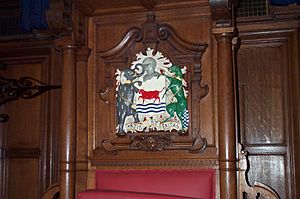
By 1004 AD, the first bridge over the River Cherwell existed, where Magdalen Bridge is today. Important meetings were held in Oxford, including one in 1018 AD where Cnut the Great was recognized as King of England.
Around 1071–1073, Oxford Castle was built by the Norman baron Robert D'Oyly. This castle was a strong fortress with a large mound (motte) and a courtyard (bailey). Academic teaching was first recorded in Oxford in 1096 AD, marking the very early days of the university.
The 12th Century: A Time of Growth
The 12th century saw more important buildings and events in Oxford.
- Around 1110 AD, the Priory of St Nicholas was established.
- In 1122 AD, the Priory of St Frideswide was officially started, and the original All Saints Church was built.
- In 1126 AD, King Henry I established a hospital for people with leprosy and St Bartholomew's Chapel.
- Osney Abbey was founded in 1129 AD, becoming an abbey in 1154 AD.
- Godstow nunnery was established in 1131 AD.
In 1133 AD, King Henry I lived in his new Beaumont Palace. An English theologian, Robert Pullen, began teaching in Oxford around this time.
Oxford experienced a major fire in 1138 AD. During a period of civil war called The Anarchy (1139-1153), Empress Matilda fled to Oxford in 1141 AD. King Stephen captured Oxford and besieged Matilda in the castle in 1142 AD. Matilda famously escaped across the snow in a white cape to hide herself.
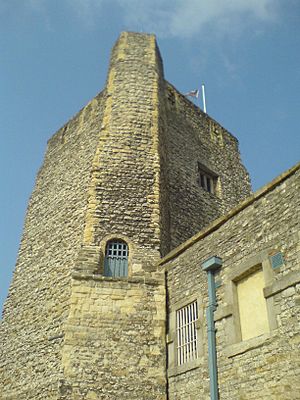
Two future kings were born in Beaumont Palace: Richard I of England ("the Lionheart") in 1157 AD and John, King of England in 1166 AD.
A big change happened in 1167 AD when English students were not allowed to go to the University of Paris. This led to more students coming to Oxford, helping the university grow.
By 1191 AD, the people of Oxford were using the first known official town seal in England.
The 13th Century: Colleges Begin to Form
The 13th century was a very important time for the University of Oxford, as the first colleges started to appear.
- In 1205 AD, the first known Mayor of Oxford was in office.
- In 1209 AD, some unhappy students from Oxford left to found the University of Cambridge.
- A papal rule in 1214 AD set out the rights of scholars at the University of Oxford, and by 1216 AD, a chancellor was in charge of the university.
- Oxford Castle was first used as a prison for misbehaving students in 1216 AD.
Religious orders also came to Oxford: the Dominican Order founded Blackfriars in 1221 AD, and the Franciscans founded Greyfriars around 1224 AD.
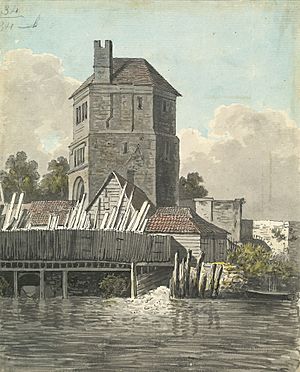
St Edmund Hall was established between 1236 and 1272 AD, becoming the oldest academic society to house and teach students in any university.
In 1238 AD, students attacked the Pope's representative, showing some tension between the university and outside authorities.
The first colleges were founded:
- University College was established around 1249 AD, using money left by William of Durham.
- Balliol College was founded around 1263 AD by John I de Balliol. His wife, Dervorguilla of Galloway, later made sure it was properly set up.
- Merton College was formally founded in 1264 AD by Walter de Merton. Its library, started around 1276 AD, is believed to be the world's oldest university library still in use.
There were also "town and gown" riots in 1263 AD, showing conflicts between the local people and the students. In 1264 AD, King Henry III even stopped teaching at the university for a while to use Oxford as a military base during a war.
Gloucester College was founded in 1283 AD for Benedictine monks. By 1300 AD, the famous philosopher Duns Scotus was studying in Oxford.
The 14th Century: More Colleges and Challenges
The 14th century brought more growth to the university, but also challenges like the Black Death.
- In 1310 AD, Mob Quad at Merton College was completed. This was the first building specifically designed for student living.
- Exeter College was founded in 1314 AD by Walter Stapledon.
- Oriel College was founded in 1324 AD by Adam de Brome with permission from King Edward II.
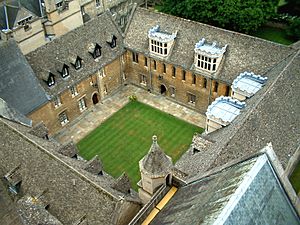
In 1327 AD, the university got its first library when Thomas Cobham, Bishop of Worcester, left his books to Oxford.
A strange event happened in 1333 AD when some northern students tried to start a new university in Stamford, Lincolnshire, after fights between student groups. Oxford's Chancellor quickly stopped this.
The Queen's College was founded in 1341 AD by Robert de Eglesfield in honor of Queen Philippa of Hainault.
The devastating Black Death arrived in Oxford in November 1348, causing many deaths until June 1349.
A major "town and gown" riot, the St Scholastica Day riot, broke out on February 10, 1355. This conflict between students and townspeople resulted in many deaths on both sides.
Canterbury College was founded in 1362 AD. New College was founded in 1379 AD by William of Wykeham. It was the first college to focus a lot on undergraduate education and had a special entrance tower and T-shaped chapel.
In 1381 AD, John Wycliffe was forbidden from teaching at the university because of his religious ideas.
The 15th Century: Printing and New Buildings
The 15th century saw more colleges and the arrival of printing in Oxford.
- Lincoln College was founded in 1427 AD by Richard Fleming.
- All Souls' College was founded in 1438 AD by Henry Chichele and King Henry VI as a college for graduate students.
- Magdalen College was founded in 1458 AD by William Waynflete. Its chapel and cloister were completed around 1478 AD.
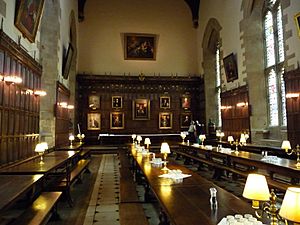
The first book was printed in Oxford on December 17, 1478. The printer, Theoderic Rood, from Cologne, was working in Oxford by 1481 AD.
Magdalen College School was established around 1480 AD.
The university's Divinity School was completed in 1488 AD, with Duke Humfrey's Library on the upper floor. This library housed manuscripts given by Humphrey, Duke of Gloucester.
Construction began on the famous tower of Magdalen College around 1490 AD.
The 16th Century: Reformation and New Foundations
The 16th century was a time of big changes, especially with the English Reformation.
- The Magdalen Tower was completed in 1509 AD.
- Brasenose College was started in 1509 AD.
- Corpus Christi College was founded in 1517 AD by Richard Foxe.
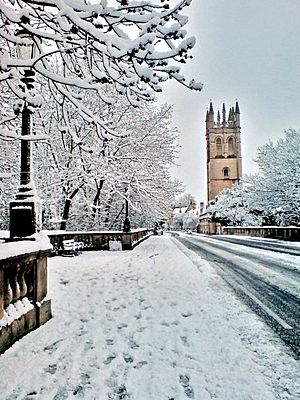
King Henry VIII visited Oxford in 1510 and 1523. In 1525, Cardinal Wolsey founded Cardinal College, which was meant to be a grand new college. However, work stopped when Wolsey fell from power. It was later refounded as King Henry VIII's College in 1532 and then as Christ Church in 1546.
The Dissolution of the Monasteries by Henry VIII in the 1530s led to the closure of many religious institutions in Oxford, including Rewley Abbey, Greyfriars, Osney Abbey, and Godstow nunnery.
In 1542, the Diocese of Oxford was created, making Oxford a city.
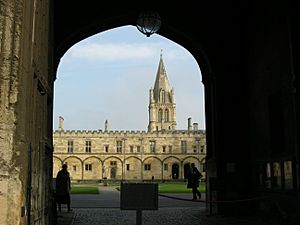
Two new colleges were founded in 1555:
- St John's College was founded by Sir Thomas White to teach Catholic theology.
- Trinity College was founded by Thomas Pope for the same purpose.
Oxford also saw the execution of the Oxford Martyrs during this period. Hugh Latimer and Nicholas Ridley were burned at the stake in Broad Street in 1555, followed by Thomas Cranmer in 1556.
Queen Elizabeth I visited Oxford in 1566 and 1592, staying at Christ Church. During her 1566 visit, the first honorary degrees were given out.
Jesus College was established in 1571 by Hugh Price, making it the first college founded as an Anglican institution.
In 1577, a terrible outbreak of epidemic typhus, known as the "Black Assize," killed around 300 people in the city.
The Oxford University Press was officially recognized in 1586. In 1598, Thomas Bodley began to rebuild the university's library, which would become the famous Bodleian Library.
The 17th Century: Civil War and Scientific Discoveries
The 17th century was a dramatic time for Oxford, including the English Civil War and important scientific advances.
- The Bodleian Library officially opened on November 8, 1602.
- In 1605, King James I and Queen Anne visited the university.
- Wadham College was founded in 1610 by Dorothy Wadham.
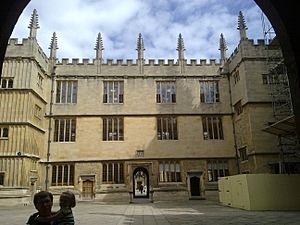
The University of Oxford Botanic Garden, the oldest botanical garden in the British Isles, was founded in 1621.
Pembroke College was founded in 1624.
During the English Civil War, King Charles I made Oxford his headquarters in 1642, staying at Christ Church. The city was besieged by Parliamentarian troops three times between 1644 and 1646. In 1646, the Royalist forces in Oxford surrendered, ending the First English Civil War.
After the war, the Oxford Philosophical Club was formed, a group of natural scientists who met to discuss new ideas. This group was a very early version of the famous Royal Society of London.
England's first coffee house opened in Oxford in 1651.
From 1655 to 1668, Robert Boyle, a famous scientist, lived in Oxford. With the help of Robert Hooke, he conducted important experiments on air using an improved air pump.
In 1665, the royal court moved to Oxford to escape the Plague in London, with King Charles II living at Christ Church. The first issue of The London Gazette, the oldest surviving newspaper, was published in Oxford as The Oxford Gazette.
The Sheldonian Theatre, designed by Christopher Wren, opened in 1669. It was built for university ceremonies and the University Press.
In 1677, Elias Ashmole gave his collection to the university, starting the Ashmolean Museum. This collection included a stuffed dodo. The Ashmolean Museum opened in 1683 as the world's first purpose-built university museum.
The Oxford Parliament met in Oxford in 1681, the last time Parliament met outside London.
In 1687, King James II tried to force Magdalen College to become Catholic, leading to protests and riots.
The 18th Century: New Architecture and Enlightenment
The 18th century saw more grand buildings and the rise of new ideas.
- The spire of All Saints Church collapsed in 1700, and the church was rebuilt between 1706 and 1708.
- Edmond Halley, a professor of geometry, identified the orbit of Halley's Comet from his observatory in Oxford in 1705.
- The Queen's College underwent major rebuilding from 1707 to 1760.
- The Clarendon Building, designed by Nicholas Hawksmoor, was built for the Oxford University Press between 1711 and 1715.
- Worcester College was founded in 1714.
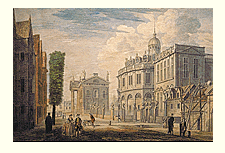
In 1729, Charles Wesley and his brother John started the Holy Club, which was the beginning of Methodism.
The circular Radcliffe Library, designed by James Gibbs, opened in 1749. It was built with money left by Dr John Radcliffe.
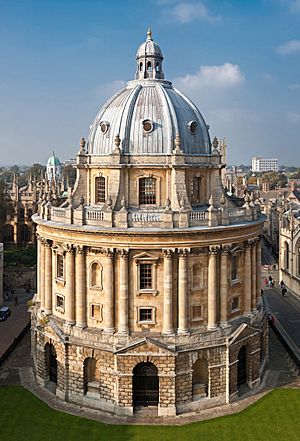
Jackson's Oxford Journal, a local newspaper, began publication in 1753.
In 1770, the Radcliffe Infirmary admitted its first patients. The Mileways Act of 1771 led to big improvements in the city streets, including the demolition of old gates and prisons.
The Covered Market opened in 1774, providing a sheltered place for traders.
In 1784, James Sadler made the first hot air balloon flight in England, starting from Oxford.
The Oxford Canal was fully opened in 1790, connecting Oxford to Coventry.
In 1791, the famous composer Joseph Haydn was awarded an honorary doctorate of music in Oxford.
The 19th Century: Railways, Reforms, and New Ideas
The 19th century brought railways, important university reforms, and new cultural movements.
- In 1811, the poet Percy Bysshe Shelley was expelled from the university for publishing a pamphlet about atheism.
- The Radcliffe Observatory began keeping continuous meteorological records in 1813.
- In 1814, important figures like The Prince Regent and Tsar Alexander of Russia visited Oxford and received honorary degrees.
- The first Eights Week rowing event was held in the summer of 1815.
- The Oxford Union, a famous student debating society, was established in 1823.
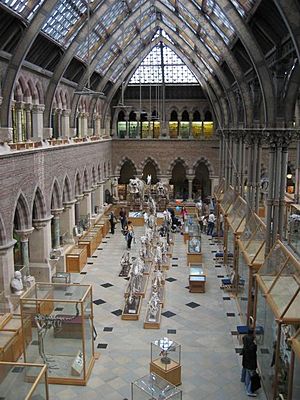
The Great Western Railway opened its branch to Oxford in 1844, bringing train services to the city.
The Oxford University Act 1854 was a big reform for the university. It allowed students who were not members of the Church of England to study there.
The University Museum was the site of a famous debate about evolution in 1860.
In 1862, Charles Dodgson (who wrote as 'Lewis Carroll') told the story that became Alice's Adventures in Wonderland during a rowing trip on the River Isis.
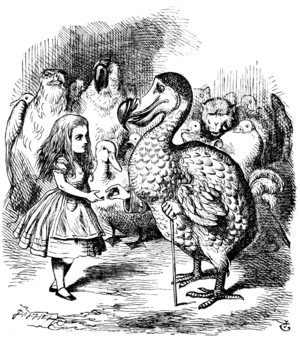
Keble College was founded in 1870, and its chapel was dedicated in 1876.
The Universities Tests Act 1871 removed more restrictions, allowing people who were not members of the Church of England to access ancient universities.
The first Varsity Match in rugby union between Oxford and Cambridge was played in 1872, with Oxford winning.
Hertford College was founded in 1874. That same year, Frank Cooper's Oxford marmalade was first made by his wife Sarah.
Oxford High School for girls opened in 1875.
In 1879, B. H. Blackwell opened the first Blackwell's bookshop, which is still famous today. Also in 1879, the first women students were admitted to the newly opened Lady Margaret Hall and Somerville Hall.
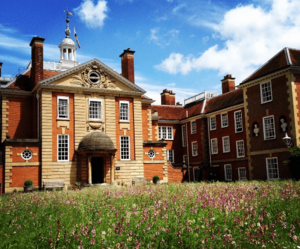

The City of Oxford Tramways Company opened its first tram route in 1881.
The Oxford English Dictionary began publishing its first parts in 1884. James Murray, the editor, moved to Oxford in 1885 to work full-time on this huge project.
Mansfield College, a nonconformist institution, moved to Oxford in 1886. St Hugh's College was also founded in 1886 for women.
In 1889, Oxford became a county borough, and its city boundaries were expanded.
In 1893, the Shelley Memorial was opened at University College, honoring the poet Percy Bysshe Shelley. Also, St Hilda's College was founded for women students.
Oxford United F.C. was formed in 1893 as Headington Football Club.
In 1894, Oliver Lodge demonstrated radio transmission in Oxford, sending Morse code signals between university buildings.
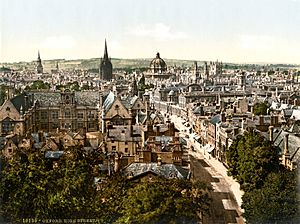
Thomas Hardy's novel Jude the Obscure, which featured a fictional Oxford called "Christminster," was published in 1895.
The new Oxford Town Hall officially opened in 1897.
In 1899, Ruskin Hall began offering classes for working-class students.
The 20th Century: Modernization and World Events
The 20th century brought significant changes, including the growth of the car industry, world wars, and further university developments.
- The Radcliffe Science Library opened a new building in 1901.
- The Rhodes Scholarship was established in 1902, bringing students from around the world to Oxford.
- The Ashmolean Museum of Art and Archaeology was formed in 1908 by merging existing collections.
In 1913, William Morris's Morris Oxford car, assembled in Cowley, went on sale. This marked the beginning of Oxford's important car manufacturing industry.
During World War I, Oxford played a role as a military hospital site, and refugees from Belgium and Serbia were accommodated in the city.
In 1917, the University introduced the Doctor of Philosophy (D.Phil.) degree.
A major milestone for women happened in 1920: the first 100 women were admitted to study for full degrees at the University, and the first women received degrees. Queen Mary became the first woman to receive an honorary degree in 1921.
The Oxford Playhouse opened in 1923.
In 1924, MG Cars was established in Oxford.
C. S. Lewis became a Fellow of Magdalen College in 1925, and J. R. R. Tolkien returned to the University as a professor. They would later become famous friends and writers.
The Pressed Steel Company plant was set up in Cowley in 1926, further boosting Oxford's industry.
The first inter-university Women's Boat Race was rowed in 1927, with Oxford winning.
The Oxford English Dictionary was completed in 1928 after 70 years of work!
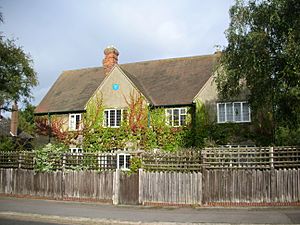
City boundaries expanded in 1929, incorporating areas like Cowley and Headington.
In 1931, Albert Einstein lectured at Rhodes House and spent two summers living at Christ Church.
South Park was acquired by the Oxford Preservation Trust in 1932, protecting it for public use.
A famous debate, "The King and Country debate", took place at the Oxford Union in 1933, where students voted not to fight for King and country in any circumstances.
Oxford became the first place in Britain to introduce a 30 mph speed limit in built-up areas in 1933.
Nuffield College was founded in 1937 by Lord Nuffield as a graduate college for social sciences.
During World War II, Oxford played a crucial role in the development of penicillin. In 1940, Howard Florey and his team at the University's Sir William Dunn School of Pathology published their results showing penicillin's effectiveness. In 1941, Reserve Constable Albert Alexander became the first person treated with penicillin intravenously, though he did not survive due to limited supply.
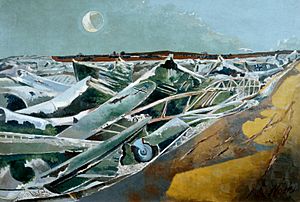
The Oxford Committee for Famine Relief was founded in 1942, which later became the international charity Oxfam. The New Bodleian Library building was officially opened in 1946.
Oxford began twinning with other cities, starting with Leiden in the Netherlands in 1946 and Bonn, West Germany, in 1947.
The new Morris Minor car was launched in 1948.
In 1949, the foundation stone for Nuffield College was laid.
The Oxford University parliamentary constituency was abolished in 1950.
In 1954, Oxford graduate Roger Bannister became the first person in the world to run a four-minute mile at the University's Iffley Road Track.
Dorothy Hodgkin published the structure of vitamin B12 in 1955, for which she would later win the Nobel Prize in Chemistry.
St Edmund Hall became a full college in 1957.
The Cutteslowe Walls, which had divided a private estate from a council estate, were permanently demolished in 1959.
The first production Mini-Minor car from the Cowley plant was made in 1959.
In 1962, Oxford United F.C. was elected to The Football League. The style of Mayor of Oxford was elevated to Lord Mayor.
Women were allowed to become members of the Oxford Union student debating society in 1962.
In 1963, The Beatles played their only live concert in Oxfordshire at the Carfax Assembly Rooms.
The original Westgate Shopping Centre was built between 1970 and 1972.
The John Radcliffe Hospital opened its maternity unit in 1972.
In 1973, J. R. R. Tolkien was buried in Wolvercote Cemetery. That same year, the first woman, Dr. Carol Clark, was elected as a fellow in a previously all-male college (Balliol).
In 1974, five previously all-male colleges admitted women undergraduates for the first time.
Colin Dexter's detective novel Last Bus to Woodstock, introducing Inspector Morse, was published in 1975.
Raymond Blanc opened his first restaurant, Les Quat' Saisons, in Summertown in 1977.
Helen House, the world's first children's hospice, was set up in 1982.
In 1985, Margaret Thatcher was refused an honorary degree by the university, a rare event for a Prime Minister. That same year, 13-year-old Ruth Lawrence became the youngest British person to earn a first-class degree, in Mathematics.
Oxford United F.C. won the Football League Cup in 1986. The famous The Headington Shark sculpture was installed on a house roof. The band Radiohead played their first gig in Oxford.
The Inspector Morse television series, filmed in Oxford, began airing in 1987.
The Oxford University Press Printing House closed in 1989.
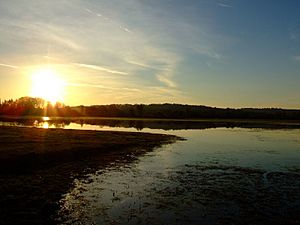
In 1992, Oxford Polytechnic became Oxford Brookes University.
Philip Pullman's young-adult fantasy novel Northern Lights, which starts in a parallel-universe Oxford, was published in 1995.
The Saïd Business School was formed in 1996.
The 21st Century: New Millennium, New Discoveries
The 21st century has seen Oxford continue to be a hub of innovation and education.
- In 2000, BMW began production of the new Mini car at the Cowley plant.
- Oxford United F.C. moved to the Kassam Stadium in 2001.
- The Saïd Business School's new building opened in 2001 on the site of the old Rewley Road railway station.
- The film Harry Potter and the Philosopher's Stone featured scenes filmed in the Bodleian Library in 2001.
The Oxford University Police ("Bulldogs") were abolished in 2003.
In 2006, the Oxford Castle quarter, the former prison, reopened as a mixed-use heritage site, hotel, and restaurant complex.
The Radcliffe Infirmary hospital closed in 2007, and its site was given to the University for development.
In 2008, St Hilda's, the last female-only college in the University of Oxford, started to admit male undergraduates, ending single-sex education in the University.
The Ashmolean Museum reopened in 2009 after a major reconstruction.
In 2011, the Bodleian Library opened its "Gladstone Link," a former underground bookstore.
The Blavatnik School of Government took its first students in 2012.
In 2013, the Andrew Wiles building for the Mathematical Institute, University of Oxford opened.
The new Bodleian Library building reopened in 2014 as the Weston Library after major reconstruction.
In 2015, the women's and men's Boat Races were rowed on the same course on the same day for the first time, with Oxford winning both.
In 2016, Louise Richardson became the first female Vice-Chancellor of the University of Oxford.
The new Westgate shopping centre opened in 2017.
In 2019, the University of Oxford announced its largest-ever donation, £150 million, to fund a new Institute for Ethics in Artificial Intelligence and a Humanities Centre.
The COVID-19 pandemic reached Oxford in March 2020. The COVID-19 vaccine AZD1222, developed by the University of Oxford's Jenner Institute and Oxford Vaccine Group with AstraZeneca, was approved for use in December 2020.
In 2023, a malaria vaccine developed by the University of Oxford's Jenner Institute was approved by the World Health Organization.
Notable Births in Oxford
Many famous people were born in Oxford over the centuries. Here are just a few:
- 1157: Richard I of England ("the Lionheart"), King of England.
- 1166: John, King of England, King of England.
- c.1560: Thomas Harriot, a brilliant scientist and mathematician.
- 1583: Orlando Gibbons, a famous composer.
- 1632: Anthony Wood, a historian who wrote about Oxford.
- 1753: James Sadler, England's first hot air balloonist.
- 1839: Jane Burden, a famous artist's model.
- 1842: Henry Taunt, a well-known photographer of Oxford.
- 1893: Dorothy L. Sayers, a popular author of detective stories.
- 1942: Stephen Hawking, a world-renowned theoretical physicist and cosmologist.
- 1945: Jacqueline du Pré, a brilliant cellist.
- 1959: Hugh Laurie, a famous actor.
- 1965: Sophie, Countess of Wessex, a member of the royal family.
- 1975: Liz Truss, who became Prime Minister of the UK in 2022.
- 1996: Florence Pugh, a well-known actress.
Notable Deaths in Oxford
Oxford has also been the final resting place for many significant figures.
- 727: Frideswide, the abbess who founded a nunnery in Oxford.
- 1040: Harold Harefoot, King of England.
- 1292: Roger Bacon, a friar, philosopher, and scientist.
- 1644: Brian Twyne, an antiquary and historian of Oxford.
- 1703: John Wallis, a famous mathematician.
- 1862: William Turner, a watercolour artist known for his landscapes.
- 1882: E. B. Pusey, an important figure in the Oxford Movement.
- 1893: Benjamin Jowett, a theologian and academic reformer.
- 1932: George Claridge Druce, a botanist and former mayor of Oxford.
- 1941: Sir Arthur Evans, the archaeologist who discovered Minoan civilization.
- 1963: C. S. Lewis, the beloved author of The Chronicles of Narnia.
- 1973: J. R. R. Tolkien, the author of The Lord of the Rings.
- 1988: Nikolaas Tinbergen, a Nobel Prize-winning animal behaviourist.
- 2017: Colin Dexter, the writer who created the popular Inspector Morse detective novels.
- 2018: Sir Roger Bannister, the first person to run a four-minute mile.
|


